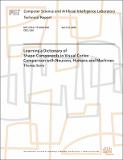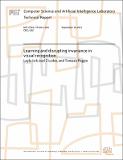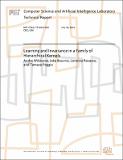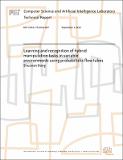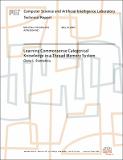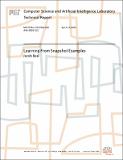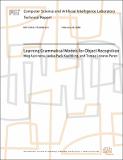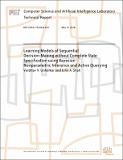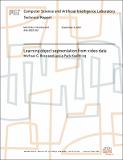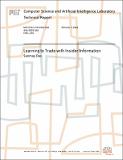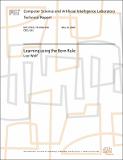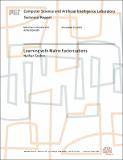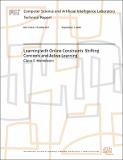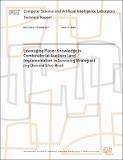Browsing CSAIL Digital Archive by Title
Now showing items 389-408 of 806
-
Learning a Dictionary of Shape-Components in Visual Cortex: Comparison with Neurons, Humans and Machines
(2006-04-25)In this thesis, I describe a quantitative model that accounts for the circuits and computations of the feedforward path of the ventral stream of visual cortex. This model is consistent with a general theory of visual ... -
Learning and disrupting invariance in visual recognition
(2011-09-10)Learning by temporal association rules such as Foldiak's trace rule is an attractive hypothesis that explains the development of invariance in visual recognition. Consistent with these rules, several recent experiments ... -
Learning and Invariance in a Family of Hierarchical Kernels
(2010-07-30)Understanding invariance and discrimination properties of hierarchical models is arguably the key to understanding how and why such models, of which the the mammalian visual system is one instance, can lead to good ... -
Learning and recognition of hybrid manipulation tasks in variable environments using probabilistic flow tubes
(2012-08-23)Robots can act as proxies for human operators in environments where a human operator is not present or cannot directly perform a task, such as in dangerous or remote situations. Teleoperation is a common interface for ... -
Learning by Learning To Communicate
(2007-08-23)Human intelligence is a product of cooperation among many different specialists. Much of this cooperation must be learned, but we do not yet have a mechanism that explains how this might happen for the "high-level" agile ... -
Learning Commonsense Categorical Knowledge in a Thread Memory System
(2004-05-18)If we are to understand how we can build machines capable of broadpurpose learning and reasoning, we must first aim to build systemsthat can represent, acquire, and reason about the kinds of commonsenseknowledge that we ... -
Learning complex cell invariance from natural videos: A plausibility proof
(2007-12-26)One of the most striking feature of the cortex is its ability to wire itself. Understanding how the visual cortex wires up through development and how visual experience refines connections into adulthood is a key question ... -
Learning From Snapshot Examples
(2005-04-13)Examples are a powerful tool for teaching both humans and computers.In order to learn from examples, however, a student must first extractthe examples from its stream of perception. Snapshot learning is ageneral approach ... -
Learning Generic Invariances in Object Recognition: Translation and Scale
(2010-12-30)Invariance to various transformations is key to object recognition but existing definitions of invariance are somewhat confusing while discussions of invariance are often confused. In this report, we provide an operational ... -
Learning Grammatical Models for Object Recognition
(2008-02-25)Many object recognition systems are limited by their inability to share common parts or structure among related object classes. This capability is desirable because it allows information about parts and relationships in ... -
Learning Models of Sequential Decision-Making without Complete State Specification using Bayesian Nonparametric Inference and Active Querying
(2018-05-17)Learning models of decision-making behavior during sequential tasks is useful across a variety of applications, including human-machine interaction. In this paper, we present an approach to learning such models within ... -
Learning object segmentation from video data
(2003-09-08)This memo describes the initial results of a project to create aself-supervised algorithm for learning object segmentation from videodata. Developmental psychology and computational experience havedemonstrated that the ... -
Learning Semantic Scene Models by Trajectory Analysis
(2006-02-10)In this paper, we describe an unsupervised learning framework to segment a scene into semantic regions and to build semantic scene models from long-term observations of moving objects in the scene. First, we introduce two ... -
Learning Solutions of Similar Linear Programming Problems using Boosting Trees
(2010-09-18)In many optimization problems, similar linear programming (LP) problems occur in the nodes of the branch and bound trees that are used to solve integer (mixed or pure, deterministic or stochastic) programming problems. ... -
Learning to Trade with Insider Information
(2005-10-07)This paper introduces algorithms for learning how to trade usinginsider (superior) information in Kyle's model of financial markets.Prior results in finance theory relied on the insider having perfectknowledge of the ... -
Learning using the Born Rule
(2006-05-16)In Quantum Mechanics the transition from a deterministic descriptionto a probabilistic one is done using a simple rule termed the Bornrule. This rule states that the probability of an outcome ($a$)given a state ($\Psi$) ... -
Learning with Matrix Factorizations
(2004-11-22)Matrices that can be factored into a product of two simpler matricescan serve as a useful and often natural model in the analysis oftabulated or high-dimensional data. Models based on matrixfactorization (Factor Analysis, ... -
Learning with Online Constraints: Shifting Concepts and Active Learning
(2006-09-01)Many practical problems such as forecasting, real-time decisionmaking, streaming data applications, and resource-constrainedlearning, can be modeled as learning with online constraints. Thisthesis is concerned with analyzing ... -
The Levels of Understanding framework, revised
(2012-05-31)I discuss the "levels of understanding" framework described in Marr's Vision and propose a revised and updated version of it to capture the changes in computation and neuroscience over the last 30 years.

